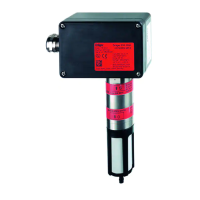Dräger Safety AG & Co. KGaA – Revalstraße 1, D-23560 Lübeck, Germany
Tel. +49 451 8 82 - 27 94 – Fax +49 451 8 82 - 49 91
www.draeger.com
If the corresponding connection is available: Electrically connect the terminal box with earth.
For installation in protection pipe: cast protection pipe seals and allow to harden.
Do not connect gas transmitter to the power supply before the wiring is complete and has been tested.
When installing a complete set (see "Order List" in the Instructions for Use of the Dräger PIR 3000): Depending on the housing type of the
terminal box there are the following permissible conductor cross sections:
Colour code of connecting terminals and/or leads at the gas transmitter:
— The leads between central device and gas transmitter must have a sufficiently low resistance to ensure the correct supply voltage at the
gas transmitter. The maximum resistance per core is calculated as follows:
Example: With U
C
= 24 V, the result is a maximum resistance per core of R = 35 ¾. With cable lengths per core of 1000 m, the resistance
per unit length R’ = 35 ¾/1000 m = 35 ¾/km may not be exceeded.
— The maximum resistance of the loop R
I
(sum of the internal resistance of the central device and of the cable resistance of the signal line)
depends on the transmitter supply voltage as described below:
Commissioning of the System
The Dräger PIR 3000 infrared gas transmitter is preconfigured and ready for use after installation.
To avoid false alarms, the alarm call to the central device is to be deactivated.
When the supply voltage is applied, the gas transmitter automatically performs a self check (10 seconds). Then it automatically uses the
calibration (see Instructions for Use) and target gas category set for delivery.
For the duration of the self test, a signal of 1 mA is issued.
Wait for the running-in period of one minute to expire. No settings can be changed at the gas transmitter during this phase. During the
running-in period, the gas transmitter emits a 1 mA signal.
Check signal transmission and adjust if required (see Instructions for Use "Checking the signal transmission", "Checking the alarm trigger"
and "Displaying the target gas category".
Check setting of the target gas category for the intended use. Set target gas category if required (see Instructions for Use "Changing the
target gas category").
Check the calibration of the gas warning system (see Instructions for Use "Calibration").
Reactivate the alarm call to put the system back to normal operating state.
Technical Data (Extract)
— For approvals, measuring technique characteristics and cross sensitivities, see Instructions for Use.
Order No. 68 11 160: 1.0 to 2.5 mm
2
Order No. 68 11 270: 0.5 to 4.0 mm
2
Order No. 68 11 180: 0.2 to 4.0 mm
2
1 = black = – (common reference potential)
2 = brown = 4 to 20 mA signal output
3 = red = + (10 to 30 V DC)
R = 2.5 x U
C
– 25
with R: maximum resistance per core
U
C
: voltage supplied by central device in volts (usually depends on the supply voltage of the central device)
NOTICE
Cable resistance deviations caused by temperature influences, transition resistances of terminals, etc. can also contribute to the fact that the
calculated cable length can not be fully used.
Transmitter supply voltage: 10 V 12 V 14 V 16 V
Maximum resistance of loop R
I
: 200 ¾ 300 ¾ 390 ¾ 480 ¾
NOTICE
To prevent moisture condensation on the optic surfaces of the device, parts of the transmitter housing are heated from the inside. This can
increase the surface temperature by approx. 5
o
C.
Standard operating range /
target gas categories
0 to 100 %LEL / methane, propane, ethylene
output signal 4 to 20 mA
supply / power consumption 10 to 30 V DC / ≤2 W
connecting thread M25x1.5 or 3/4" NPT
environmental operating ranges –40 to 65
o
C, 700 to 1300 hPa, 0 to 100 % relative humidity
environmental storage ranges –40 to 70
o
C, 700 to 1300 hPa, 0 to 100 % relative humidity, non-condensing
IP rating IP 66, IP 67, NEMA 4X&7
90 23 813 - MA 4677.500 en
© Dräger Safety AG & Co. KGaA
Edition 05 - July 2018 (Edition 01 - September 2005)
Subjects to alteration

